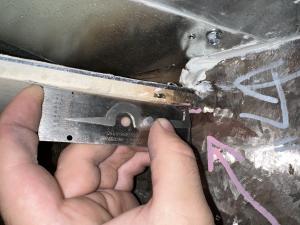Crucial Tips for Effective Welding Inspection Racine Services
Crucial Tips for Effective Welding Inspection Racine Services
Blog Article
Innovative Techniques to Fillet Weld Examination and Screening: Enhancing Weld High Quality and Conformity Standards
In the realm of welding, the high quality and honesty of fillet welds play a crucial function in making sure the architectural stability and dependability of numerous commercial parts. With the constant drive for improved performance and compliance with rigid standards, the exploration of ingenious approaches to fillet weld assessment and testing has actually become critical. As markets progress, the traditional approaches might no more be enough in meeting the needs of modern-day welding applications. By accepting sophisticated innovations and methodologies, a new horizon of possibilities arises in the realm of weld quality evaluation and adherence to compliance requirements.
Advanced Non-Destructive Testing Methods
Utilizing cutting edge modern technologies, progressed non-destructive testing approaches play a vital duty in ensuring the stability and quality of fillet welds. These methods, such as phased selection ultrasonic screening (PAUT) and magnetic particle screening (MPT), deal in-depth insights into the weld's inner structure without triggering any damages to the product. PAUT, for example, utilizes numerous ultrasonic components to check the weld from various angles, offering an extensive visualization of prospective issues like lack of blend or cracks.
By utilizing these advanced non-destructive testing techniques, weld inspectors can accurately assess the quality of fillet welds, making certain conformity with industry requirements and guidelines. The ability to spot flaws early on not just boosts weld top quality but also stops pricey rework or failures in architectural honesty, underlining the significance of these ingenious testing techniques in welding examinations.
Robotics and Automation in Assessment
The assimilation of robotics and automation has reinvented the assessment procedure for fillet welds, improving effectiveness and precision in quality analysis. Robotics provide specific control and repeatability in inspecting welds, ensuring trusted and consistent outcomes. Automated systems can be configured to comply with particular assessment courses, making sure complete insurance coverage of welds and lowering the threat of human mistake.
Robot assessment systems furnished with sophisticated sensing units can discover and determine weld features with high precision, supplying thorough data for analysis. These systems can identify flaws such as splits, lack of fusion, and porosity, enabling punctual rehabilitative activities to be taken. Furthermore, robotics and automation enable for real-time information collection and evaluation, giving instant feedback to drivers and helping with quick decision-making procedures.
In addition, using robotics and automation in fillet weld inspection improves overall performance by minimizing evaluation times and raising evaluation throughput. By enhancing the examination process, suppliers can make sure weld quality and conformity requirements are met effectively, inevitably resulting in set you back savings and enhanced item top quality.
Utilizing Artificial Intelligence for Evaluation
Fabricated intelligence plays an essential function in boosting the effectiveness and precision of analysis in fillet weld examination processes. AI formulas can rapidly process huge amounts of information from weld evaluations, discovering defects or inconsistencies that may be testing to identify with the naked eye - Welding Inspection Racine.
In addition, AI systems can find out from previous examination data, continuously enhancing their capability to determine potential issues and discrepancies in fillet welds. This adaptive understanding ability boosts the total quality assurance procedure, reducing the possibility of human error and guaranteeing that welds fulfill the needed criteria. By incorporating man-made knowledge into fillet weld analysis, industries can attain greater levels of efficiency, consistency, and compliance in their evaluation methods.
Portable Tools for On-Site Inspection
 Enhancing area inspection efficiency, the fostering of portable tools transforms on-site evaluation procedures for fillet welds. These devices supply versatility and convenience, allowing inspectors to carry out complete examinations in various places, consisting of difficult or remote atmospheres. Mobile devices Bonuses such as ultrasonic testing gadgets, magnetic bit assessment devices, and electronic radiography systems supply real-time information and high-resolution imaging capacities, making it possible for fast decision-making and instant comments on weld high quality.
Enhancing area inspection efficiency, the fostering of portable tools transforms on-site evaluation procedures for fillet welds. These devices supply versatility and convenience, allowing inspectors to carry out complete examinations in various places, consisting of difficult or remote atmospheres. Mobile devices Bonuses such as ultrasonic testing gadgets, magnetic bit assessment devices, and electronic radiography systems supply real-time information and high-resolution imaging capacities, making it possible for fast decision-making and instant comments on weld high quality.One substantial advantage of portable tools is their capacity to improve evaluation treatments, decreasing downtime and boosting overall efficiency. Inspectors can easily transport these tools to different task sites, removing the need for transporting heavy equipment or parts to off-site centers. Furthermore, the mobility of these tools advertises cost-effectiveness by lessening transportation expenses and accelerating evaluation timelines.
Furthermore, the usage of portable devices for on-site assessment advertises proactive quality assurance procedures, as examiners can quickly determine and deal with any kind of possible welding defects or inconsistencies. By integrating these ingenious modern technologies right into on-site assessment techniques, welding specialists can make certain conformity with industry standards and improve weld high quality, inevitably resulting in improved structural integrity and safety in numerous welding applications.
Assimilation of Data Monitoring Equipment
Having actually optimized on-site evaluation procedures through the utilization of portable tools, the following phase entails the seamless combination of information management systems to additionally improve efficiency and information evaluation capabilities in fillet weld examination and testing. Welding Inspection Racine. By incorporating information monitoring systems into the examination procedure, organizations can enhance information collection, storage space, and analysis. This assimilation permits real-time surveillance of weld high quality, prompt identification of defects, and timely decision-making to fix any kind of concerns that may emerge during the assessment process
Information administration systems play an important role in streamlining examination data, promoting simple gain access to for accredited workers, and ensuring information honesty and safety. Via the assimilation of these systems, inspectors can generate comprehensive records, track historical information for fad evaluation, and boost overall process effectiveness. Moreover, the assimilation of data monitoring systems enables seamless interaction between different stakeholders involved in the inspection process, fostering collaboration and improving general quality assurance steps. Ultimately, the combination of data administration systems serves to raise the standards of fillet weld assessment and testing, guaranteeing conformity with market policies and improving weld quality.
Final Thought
In verdict, cutting-edge approaches to fillet weld assessment and testing have actually considerably improved weld top quality and compliance requirements. Advanced non-destructive screening approaches, robotics, automation, expert system, mobile devices, and data management systems have actually transformed the you can try these out way weld inspections are carried out. By making use of these modern technologies, sectors can ensure that welds meet the required top quality standards and laws, inevitably enhancing total effectiveness and security in welding processes.

By using these sophisticated non-destructive testing strategies, weld examiners can precisely evaluate the top quality of fillet welds, ensuring conformity with market criteria and guidelines. Mobile devices such as ultrasonic screening tools, magnetic particle assessment equipment, and electronic radiography systems give real-time data and high-resolution websites imaging capacities, allowing quick decision-making and instant feedback on weld quality.
Having actually enhanced on-site examination procedures with the application of portable devices, the following phase involves the seamless combination of data administration systems to additionally enhance effectiveness and data analysis capacities in fillet weld evaluation and screening (Welding Inspection Racine). Inevitably, the combination of data monitoring systems offers to boost the requirements of fillet weld assessment and testing, making certain conformity with industry laws and boosting weld quality
 In final thought, innovative methods to fillet weld examination and testing have actually considerably boosted weld quality and compliance criteria.
In final thought, innovative methods to fillet weld examination and testing have actually considerably boosted weld quality and compliance criteria.Report this page